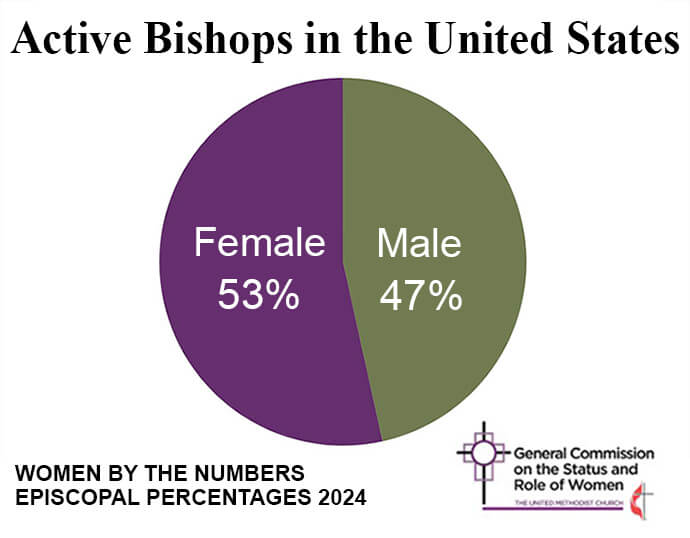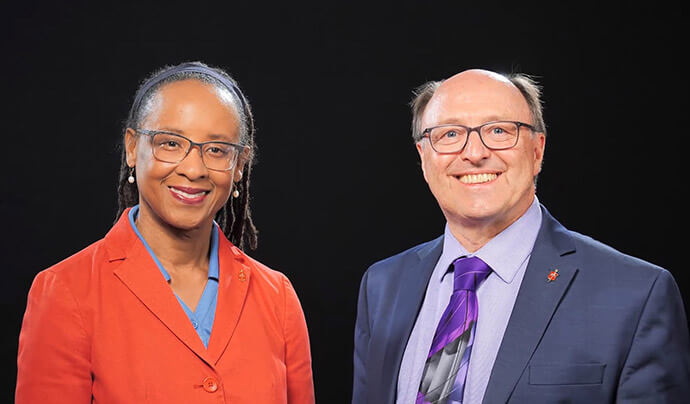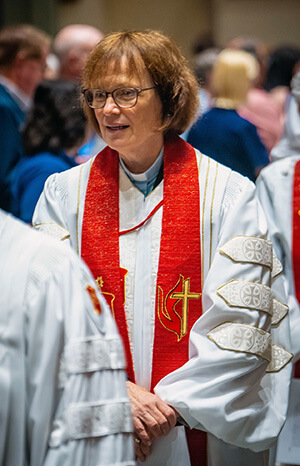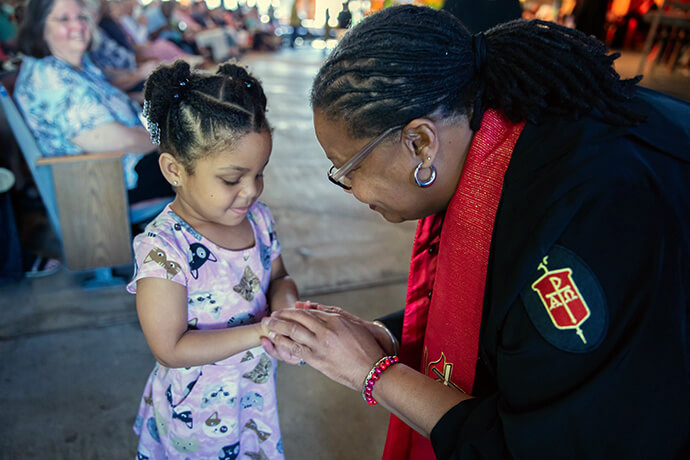Key Points:
- In a history-making development, two bishops will lead conferences across jurisdictional lines.
- It’s a significant milestone for a system initially designed 85 years ago to prevent bishops from one geographic region from overseeing churches in another region.
- The new assignments demonstrate the growing collaboration among U.S. United Methodists.
- Still, the denomination’s top court is facing questions about whether this development is in line with The United Methodist Church’s constitution.
What once seemed impenetrable boundaries on The United Methodist Church’s organizational map now look more like dotted lines.
Unprecedented collaboration among the denomination’s jurisdictional leaders has paved the way for two U.S. bishops to soon lead conferences across jurisdictional borders. Those assignments became official when jurisdictional conferences met July 10-13 across the U.S.
“I would just say the Holy Spirit was present in all of these experiences and processes, in particular ways and throughout all of the people who are participating,” said the Rev. Kim Ingram. She is the chair of the Interjurisdictional Committee on Episcopacy that led the way in developing the history-making plan for U.S. bishop assignments.
Faced with a substantially reduced denominational budget, the committee worked with bishops and other United Methodist leaders across the U.S. to come up with a plan that would both reduce the number of U.S. bishops while still providing effective episcopal oversight across the U.S. church.
Starting Sept. 1, most U.S. bishops will lead more than one conference — the denomination’s primary regional bodies, which consist of multiple congregations.
Bishop gender by the numbers

The United Methodist Commission on the Status and Role of Women monitored U.S. jurisdictional conferences across the United States to ensure transparency and advocate for the equitable representation of women in leadership roles. The commission celebrates the election of two new female bishops in the Western Jurisdiction, which after this year’s retirements means the number of active female bishops in the U.S. will be higher than male bishops.
More significantly, Bishop Debra Wallace-Padgett will lead the Southeastern Jurisdiction’s Holston Conference and the Northeastern Jurisdiction’s West Virginia Conference. Similarly, Bishop Carlo A. Rapanut will lead the Western Jurisdiction’s Desert Southwest Conference and the South Central Jurisdiction’s New Mexico Conference. The North Central Jurisdiction also got creative in its assignments, assigning two bishops to share duties in the Illinois Great Rivers Conference.
Amid all their expanded duties, Council of Bishops President Tracy S. Malone said in a statement that all United Methodist bishops will continue in their “unwavering commitment to providing vital spiritual and temporal leadership.” Malone is also seeing a change, moving from leading the East Ohio Conference to the Indiana Conference starting Sept. 1.
“We aim to become a more agile and efficient church,” she added, “… and maintain our focus on our core mission to make disciples of Jesus Christ for the transformation of the world.”
The new assignments mean four of the five jurisdictions will share bishops across boundaries.
Still, questions remain about whether this development passes muster under the denomination’s constitution. The Northeastern Jurisdiction voted to request the Judicial Council, the denomination’s top court, to rule on legal questions related to the role of the Interjurisdictional Committee on Episcopacy and the assignments across jurisdictional lines. The church court will hold its next session in October.
Even before jurisdictional conferences, the General Council on Finance and Administration — the denomination’s finance agency — raised its own concerns about how the current situation developed.
Ingram said she hopes the Judicial Council will affirm the interjurisdictional committee’s work because more like it will be needed going forward.
“It has completely opened the door for more unity, for more working together, for sharing of experiences and best practices, and not staying in our kind of siloed geographic areas but really beginning to work across the country,” she said.
The history
It’s a significant milestone for a system of episcopal leadership first formed in 1939 when what was then the Methodist Church came together after the North-South split over slavery ahead of the U.S. Civil War.
How North Central Jurisdiction handles assignments
Like its fellow jurisdictions, the North Central Jurisdiction used an innovative approach in its bishop assignments.
Starting Sept. 1, Bishop David Bard and Bishop Kennetha Bigham-Tsai will begin their joint episcopacy of the Illinois Great Rivers Conference.
Bishop Frank Beard, who has led the Illinois Great Rivers Conference since 2016, is taking long-term disability leave starting Aug. 1 as he deals with blindness caused by glaucoma. Disability leave is not the same as retirement, and federal labor law requires a similar position be available to Beard should he choose to return.
The impetus for dividing the U.S. church into different jurisdictions was to prevent Northern bishops from leading congregations in the South and vice versa. Developed the same year as the film “Gone with the Wind” was released, the system also included the Central Jurisdiction to segregate Black leaders and members from the rest of the denomination.
The formation of today’s United Methodist Church in 1968 officially brought an end to the Central Jurisdiction. But the denomination left intact the other five jurisdictions delineated along geographical lines: the Northeast, North Central, Southeast, South Central and Western jurisdictions. Over the past 85 years, these five jurisdictions also have each developed their own ministries, cultures and ways of handling the election and oversight of bishops within their borders.
Bishops have served in jurisdictions outside of where they were elected before. But usually they were on a special assignment or in an interim role assigned by the denomination’s Council of Bishops. Occasionally, bishops have transferred to another jurisdiction after they retired.
This appears to be the first time two bishops are leading episcopal areas that straddle jurisdictional lines. What makes this year’s bishop assignments especially historic is the monthslong cooperation among many non-bishop United Methodists that went into transcending jurisdictional lines.
The Rev. Amy Lippoldt, who as the South Central Jurisdiction’s episcopacy chair served on the interjurisdictional committee, was excited about the collaboration that has already taken place. But she said the interjurisdictional committee’s work over the past few months also showed that eliminating jurisdictions altogether will take time.
“That can be a great goal for us perhaps three quadrennia from now,” she said. “But as we do that, we need to begin to develop shared culture and we need to begin to develop shared understanding across those jurisdictional lines. And the way that’s going to happen is with collaboration across jurisdictional leadership, but also at the annual conference level.”
Ashley Boggan D., top executive of the United Methodist Commission on Archives and History, sees this moment as a potential turning point in the life of The United Methodist Church.
“This moment may not be signaling the dissolution of the jurisdictional system, but it is calling us to rethink how we organize ourselves given the historic change in the denomination,” she said. “How can we move beyond our racist past towards a more equitable future where jurisdictions no longer confine bishops to one area or another?”
How the church got here
The cross-jurisdictional cooperation was born of necessity after about a quarter of U.S. churches disaffiliated largely over matters around LGBTQ inclusion. What remains is a smaller but more unified United Methodist presence, at least in the U.S.
General Conference — the denomination’s international legislative assembly — recently voted overwhelmingly to overturn decades-long denomination-wide bans on same-sex marriage and gay clergy.
Subscribe to our
e-newsletter
The assembly also cut the budget by about 40% compared to what passed in 2016 — with an accompanying drop in requested giving to denominational funds. U.S. United Methodists support the bulk of the denomination’s finances. As part of the belt-tightening, General Conference voted to cut the number of active U.S. bishops from 39 to 32 and approved a recommendation for their distribution.
The Interjurisdictional Committee on the Episcopacy, which consists of lay and clergy representatives from each U.S. conference, developed the recommendation that General Conference approved for distributing the 32 bishops.
Typically the interjurisdictional committee recommends the distribution and it is up to each jurisdiction’s committee on episcopacy to handle that jurisdiction’s bishop assignments on their own.
That process was not possible this time. The interjurisdictional committee’s original plan called for no U.S. bishop elections to replace the seven retiring U.S. bishops. The plan also called for one bishop each to transfer from the Southeastern, South Central and North Central jurisdictions to fill certain vacancies — with two going to the Western Jurisdiction and one to the Northeastern.
That left the interjurisdictional episcopacy committee — a group that typically meets only for the duration of General Conference — to consult with bishops about possible transfers. The committee also had to meet various requirements of the Book of Discipline, the denomination’s policy book.
Those requirements include that:
- No bishop be transferred without that bishop’s consent.
- Each jurisdiction have a minimum of five bishops.
- A bishop must have served at least four years in the jurisdiction where elected to be eligible to transfer across jurisdictional lines. That limited how the 13 U.S. bishops elected in 2022 could serve beyond their home jurisdictions.
“There were people willing to serve,” Ingram said. “It’s just that the people weren’t in the right jurisdictions for the puzzle to work out.”

Adding to the complexity, the committee had to deal with two unexpected vacancies in bishops able to serve. Bishop Frank J. Beard, who leads the Illinois Great Rivers Conference in the North Central Jurisdiction, requested long-term disability, starting Aug. 1. Bishop Robert Schnase, who leads the New Mexico and Rio Texas conferences in the South Central Jurisdiction, announced his retirement effective Sept. 1.
As a result of the Discipline’s requirements and the additional vacancies, the current assignments look somewhat different from the initial recommendations General Conference approved.
Western and South Central
The new assignments mean all but one jurisdiction is seeing a reduction in its bishops. The Western Jurisdiction remains at the minimum of five bishops required by the Discipline.
The jurisdiction also is the only one that held elections this year to replace retiring bishops — electing Bishops Kristin Stoneking and Sandra K. Olewine.
However, Ingram of the interjurisdictional episcopacy committee and other jurisdictional leaders stress that the Western Jurisdiction sought to find two current bishops willing to transfer to the West to make elections unnecessary. Those transfers ultimately did not happen, and the unexpected vacancies opened the way for elections to take place.
Nevertheless, the Western Jurisdiction’s leaders still wanted to find a way it could help in this unusual time. That ultimately led the Western Jurisdiction episcopacy committee to work with its counterparts in the South Central Jurisdiction, including Lippoldt, to extend Bishop Rapanut’s coverage. Rapanut, elected in 2022, remains a member of the Western Jurisdiction college of bishops.

“All of the jurisdictions had to do some very creative thinking while making assignments,” said the Rev. Dan Hurlbert, who was at the time the chair of the Western Jurisdiction committee and served on the interjurisdictional committee.
He added that the entire interjurisdictional committee put in many hours of work.
“While it did not yield the transfer of active bishops, it did bring interjurisdictional work to the forefront in ways that may have never happened before,” he said.
Rapanut will be returning to Desert Southwest, which encompasses Arizona and southern Nevada including Las Vegas, and is eager to also serve its neighbor New Mexico. Arizona and New Mexico, which both became U.S. states in 1912, also share a lot of cultural similarities as part of the American Southwest.
The Rev. Ross Whiteaker, a district superintendent in New Mexico, told the conference that he has no doubt Rapanut will help the conference in moving forward.
“Within a few minutes of visiting with him, it was clear that he is a person of deep faith, he is incredibly thoughtful, and has a fun sense of humor,” Whiteaker said.
Rapanut expressed similar hopes in a video to both conferences.
“There is so much affinity between our two conferences, and so many possibilities for collaboration and cross-pollination,” Rapanut said. “I invite all of us to look with anticipation of what God has in store for us in this holy partnership. Having said that, I do acknowledge the uniqueness of each ministry setting in this circuit.”
Northeastern and Southeastern

Wallace-Padgett, who has led both the North Alabama and Holston conferences, likewise is excited to take on her new, pioneering role.
She will be returning to Holston, which encompasses eastern Tennessee, a part of northern Georgia and southwestern Virginia where it borders West Virginia. Both Holston, which is celebrating its bicentennial, and West Virginia are in Appalachia — a good fit for Wallace-Padgett, who hails from Kentucky. She also said both conferences have been very welcoming.
Wallace-Padgett, who was elected in 2012, will be a member of both jurisdictions’ colleges of bishops.
“I hope and pray that both conferences will grow increasingly effective in making disciples and developing leaders who reflect Jesus as we move into the future together,” she told United Methodist News.
Ingram, who also chairs the Southeastern Jurisdiction episcopacy committee, said Wallace-Padgett could not just transfer to the Northeastern Jurisdiction because Holston really needed her continued leadership. But the bishop was eager to help and was open to providing leadership in West Virginia.
Judi Kenaston, then chair of the Northeastern Jurisdiction episcopacy committee, acknowledged that some were disappointed that the Northeast did not hold any bishop elections this year. In 2022, the jurisdiction ended up only electing one new bishop rather than the allotted two.
The new assignment also meant adjusting the jurisdiction’s original plans for West Virginia and Western Pennsylvania to share a bishop.
The changes left many Northeastern Jurisdiction delegates with questions about what this new cross-jurisdictional assignment will mean.
Kenaston, who is also a member of the West Virginia Conference, said she thinks Wallace-Padgett has the gifts and graces to ease some of these concerns.
“She is a self-described bridge builder,” Kenaston said. “She sees herself as someone who is willing to work with people across the theological spectrum so long as those people want to remain in The United Methodist Church. To her, we are a church large enough to allow for that, and so she’s an excellent fit for West Virginia because that’s what we need.”
Ingram expressed gratitude for the work all the bishops are doing in a challenging time that requires flexibility and resilience.
“We are blessed in our episcopal leadership,” she said.
Hahn is assistant news editor for UM News. Contact her at (615) 742-5470 or newsdesk@umnews.org. Tim Tanton, chief news officer; Frances Lyons, reference archivist at United Methodist Commission on Archives and History; Alli Newsom, director of communications for the New Mexico Conference, and Christina Dillabough, director of communications for the Desert Southwest Conference, all contributed to the story. To read more United Methodist news, subscribe to the free daily or weekly Digests.





